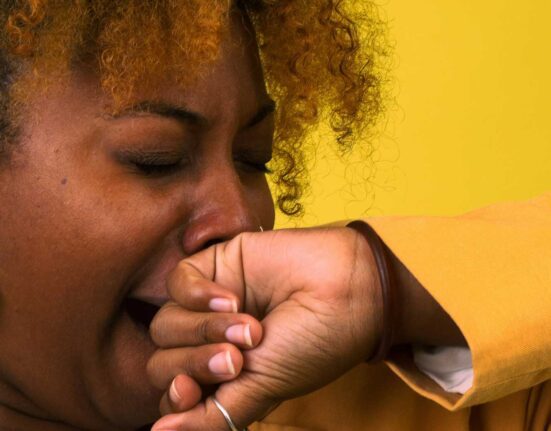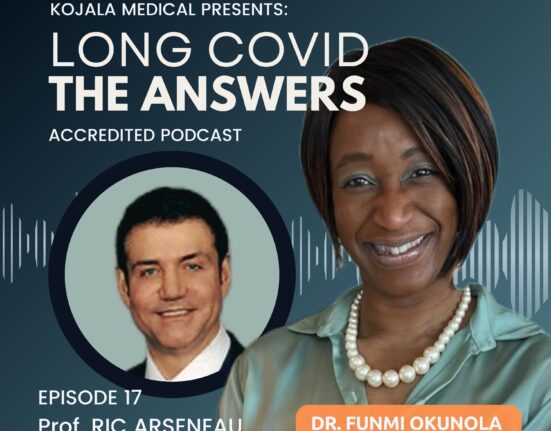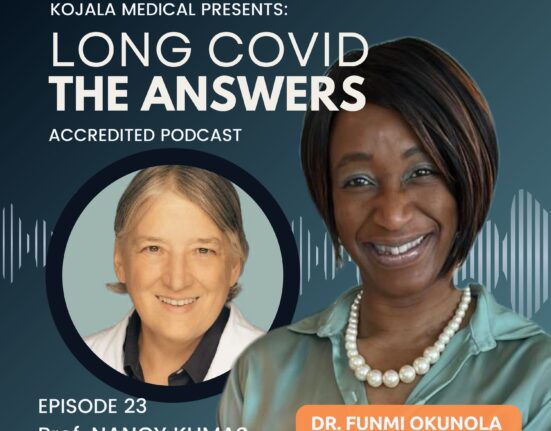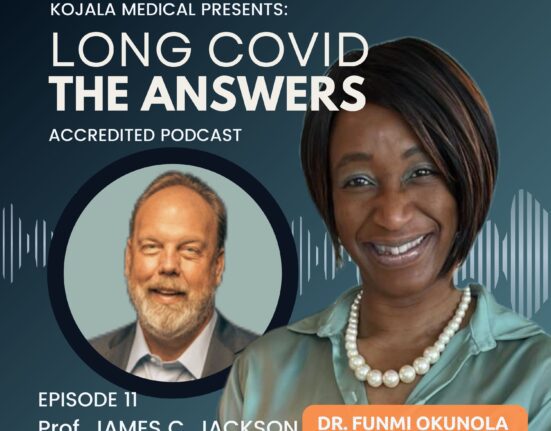
Join us as Dr. Danilo Buonsenso discusses the intricacies of diagnosing and managing Long COVID in children, emphasizing the need for a multi-disciplinary approach and recognizing age and gender differences. Discover the challenges and solutions in ensuring accurate diagnosis while excluding other conditions.
Guest – Danilo Buonsenso
Note: The podcast has no bias. All conflicts of interest are highlighted with individual guests.
Healthcare Professionals | Earn 0.5 Certified Mainpro+® Credits! Please register/login to claim your CPD/ CEU credits.
Podcast Overview:
Dr. Danilo Buonsenso explores the challenges of diagnosing and managing Long COVID in children, highlighting that symptoms often overlap with those seen in adults. He points out the under diagnosis of Long COVID, noting its significant prevalence. Buonsenso stresses the importance of recognizing age and gender differences, addressing diagnostic challenges, and employing a multi-disciplinary approach in community settings to accurately diagnose and manage Long COVID, while ensuring other conditions are excluded.
Key Points:
- Symptoms overlap with adults
- Under diagnosis is common
- Significant prevalence in children
- Age and gender differences
- Diagnostic challenges
- Multi-disciplinary approach needed
- Importance of excluding other conditions
DISCLAIMER: The information in this podcast is provided for informational purposes only. You should not use any information discussed in this podcast and related materials to make medical or healthcare related decisions. Always consult a your physician or other qualified health care provider with regards to diagnosing managing your medical condition. Any medications or treatments, including any discussed in this podcast, should be initiated and managed by a qualified health care professional.
Podcast Transcript:
Healthcare Professionals: Please note to claim Certified CPD / CEU credits toward your medical license (Canada & reciprocal CPD/CEU Worldwide), you will need to register or log in.
Episode 4 – Diagnosing and Managing Long COVID in Children with Dr Danilo Buonsenso MD PhD
[00:00:00] Funmi Okunola: The information in this podcast is provided for informational purposes only. You should not use any information discussed in this podcast and related materials to make medical or healthcare related decisions. Always consult your physician or other qualified healthcare provider with regards to diagnosing and managing your medical condition. Any medications or treatments, including any discussed in this podcast should be initiated and managed by a qualified healthcare professional.
Funmi Okunola: Welcome to Long Covid the Answers. Today’s Episode Four is entitled “Diagnosing and Managing Long COVID in Children” and is the second of a two-part series of episodes about Paediatric Long Haulers.
Funmi Okunola: I’d like to introduce Dr. Danilo Buonsenso. He is a Physician- Scientist and a specialist in Infectious Diseases in children.
Dr. Buonsenso currently works at the Department of Women, Child and Public Health at the Gemelli University Hospital in Rome, Italy. He has a PhD in public health and sciences and is currently doing his MSc in Infectious Disease at Oxford University. During the pandemic, his work extended to the clinical impact of SARS-CoV-2 infection in children from Acute Disease, Multisystem Inflammatory Syndrome in children, or MISC, and Long COVID.
He is a founder and President of the not-for-profit organization, Surf for Children, which provides medical support for children in Sierra Leone [00:01:00] and special needs support for children in Italy. He is also a champion of the charity Long COVID Kids. Welcome.
Danilo Buonsenso: I thank you very much for your introduction. I’m very happy to be here.
Funmi Okunola: We’re very happy to have you. Do you have any conflicts of interest to declare Danilo?
Danilo Buonsenso: Yes, I must declare that I have been funded by a Pfizer and Roche for two studies I’m still currently co-ordinating within the field of Long COVID. The funders had no role in the development or the plan of these studies, and also no role in the interpretation and dissemination of data and results.
Funmi Okunola: Excellent, thank you. And of course, they have no role or contribution in this interview.
Understanding Long COVID Symptoms in Children
Funmi Okunola: I’d like to now consider how a Physician or parent would go about looking for Long COVID symptoms in a child, given the widespread perception that children are rarely impacted by COVID. I believe Long COVID is either underdiagnosed [00:02:00] or misdiagnosed.
Are you in agreement with this Danilo?
Danilo Buonsenso: Yes, I think so because the pattern of signs and symptoms are very much evident for the family but may still be overlooked as a psychological problem by the healthcare professionals. It can be a real possibility that Long COVID is still not entirely recognized in many settings.
Funmi Okunola: Does the presentation of Long COVID differ between adults and children?
Danilo Buonsenso: No, I would say that the presentation is very similar. So, in children, at least in my experience, it is very uncommon before 8 to 10 years of age. It is possible, but it is uncommon or maybe can be more difficult to be recognized of course because children interact less.
But overall in the large majority of cases the classic presentation is very [00:03:00] similar in a 15 year old and in a 30, 25, 40 year old boy, woman or man, and the presentation, in my opinion, is quite characteristic because the classic presentation is that a child who was perfectly healthy – playing football, volleyball, basketball, whatever in the US, may be more frequently every day.
He got COVID or she got COVID and then is so fatigued. They have so much fatigue that they struggle even to do a flight of stairs – they sleep a lot. Any minimal activity leads to a general malaise, very high tachycardia. Many can have muscle and joint pains which leads to laying down most of the day.
Some can have neuro-cognitive issues like brain fog, or a drop in school performance. All these [00:04:00] symptoms significantly change the routine of these children. But most importantly, this sooner or later will also impact their mental health because you can imagine a perfectly well child’s routine is completely changed.
No one can tell you why your child is now severely ill because they look very healthy. This is one of the problems with Long COVID because these children look healthy – people have difficulty in trusting the disease of these children. So, they are not trusted.
Their mental health is obviously impacted. These children start missing school, missing friends, which in turn further worsens the physical and mental health symptoms. Therefore, it is very important to recognize the disease because recognizing the disease can offer the [00:05:00] possibility to enter research center studies, but also to try to implement recognition from parents, school teachers, sport teachers, friends, and also supporting any conditions we may still treat within Long COVID.
Funmi Okunola: That’s an excellent answer and pre-empted one of the questions I was going to ask.
Prevalence of Long COVID in Children
Funmi Okunola: What’s crossing my mind is the prevalence of Long COVID. In adults, we, depending on what study you look at, are looking at between 15 and 30% of adults infected with SARS- CoV-2 and probably a resting population incidence of between 5 and 7% of the adult population.
What’s the prevalence, in your opinion, of Long COVID in children?
Danilo Buonsenso: So, this is still a topic of debate. If you probably ask 10 different people, you will get 10 different answers. So, I’ll try to give a balanced perspective. [00:06:00] As you may know, many reviews report like from 5 to 20% of children having Long COVID.
But in my opinion, this figure is too high because otherwise we would be in a very catastrophic scenario. Luckily, we still see that most children are healthy and attend school or whatever. So, I think that probably the best figure nowadays comes from a Scandinavian paper which was able to do a nationwide assessment of children with or without COVID-19.
In this context, I guess that the difference between the two groups was that 0.2% of children with COVID have a possible Long COVID diagnosis. The 0.2% may look a small number, but as I told you in the previous episode, if you consider that the massive number of children infected with COVID-19, this is going to [00:07:00] be a huge number.
In terms of absolute numbers, I remember when during the first month of the pandemic there was a debate – again about the prevalence of Long COVID. I used to say that even if we have 0.1% of children with COVID getting Long COVID, this is going to be a huge number. This study actually doubled my prediction to 0.2%. So probably 0.1% is the number I would guess according to the available literature. This is a huge number of children having long term issues. It’s important that people do not do the same mistake as with COVID, that 0.1% is so small that no children get Long COVID. No, 0.1% is a relatively small risk for the individual, but it’s a massive number of children having chronic symptoms [00:08:00] impairing daily life that we still do not know perfectly how to treat. Therefore, it’s a significant impact on healthcare systems, but also on families.
Funmi Okunola: Thank you.
Age and Gender Differences in Long COVID
Funmi Okunola: The frequency of Long COVID varies depending on the age group and sex. It seems to affect girls more frequently and older children more severely. Why?
Danilo Buonsenso: Yes, most older children seem to clearly have more frequently Long COVID compared to younger children. The exact reasons are still unknown.
There are some possibilities. So, first of all older children are maybe more aware of these subtle problems compared for example, to younger children. Like the neuro-cognitive issues, the change in school performance can be much easier to be evaluated in a 14-year old, which is like an adult nowadays compared to very young children, and even the feeling of fatigue, muscle pains and [00:09:00] whatever. From one end, it can be due to easier recognition in older children. Second, the other point can be that an old adolescent is very similar to a young woman or a young man even in terms of immunological backgrounds, protective mechanisms, and the endothelial balance and whatever.
So, we probably have both. We have a cohort of patients that are similar to young adults, both physically, immunologically and also some subtle symptoms, for example, the palpitations can be more easily recognized in this cohort.
Funmi Okunola: Okay. What about the gender difference? Why more girls than boys, do you think?
Danilo Buonsenso: Yeah, so this difference is not that strong in pediatrics. It’s more evident in children, but of course, we are still seeing a few more girls than boys having Long COVID. This is [00:10:00] something that is happening in many diseases. We have an entire whole field of medicine focused on gender medicine which is trying to explain why several outcomes are different in female adults and males. We know that the difference in terms of hormonal homeostasis are clearly different between males and females, and these differences are in line with the differences we have in other autoimmune diseases.
So, we know that even other autoimmune diseases are much more frequent in adult females than males. This should not come as a surprise that even in Long COVID we are seeing a similar difference because we know that with Long COVID, we are having growing evidence from an immunological perspective that there is a role of the immune system also in Long COVID.
So again, this is in line – without [00:11:00] immunity differences between females and males, and probably there exists, there is still some role from how the hormones, sexual hormones, or other behavioral and social factors affects the manifestation of diseases.
Funmi Okunola: Okay. Thank you.
Diagnostic Methods for Long COVID in Children
Funmi Okunola: If we categorize children into different age groups, say 0 to 1 years, 1 to 7 years, 7 years and teenagers, what are the diagnostic methods for identifying Long COVID in children? Because, for instance, a young child between the ages of 0 and 1 may try to express joint pain, but how could you really discern that as a clinician?
What’s your approach in those different age groups with regards to diagnosis?
Danilo Buonsenso: This is a problem we have in paediatrics and definitely this is a good point because as I said before the group 10 to 12 and older are those that are much easier to investigate because first of all, they can report [00:12:00] some symptoms better than others.
The neuro-cognitive tests are more easily done in the older children. For the cardiopulmonary exercise testing for example is a F4 test we do on a C clad and not most centers have C clad available for patients taller than 140 centimeters.
Many tests are more difficult done in children, like the lung function tests in less collaborative children are much more difficult to be done. This is probably one of the reasons why we can easily recognize Long COVID in teenagers. We see much less Long COVID under the year of six because in this age group children may not even be recognized for first diagnostics because they don’t tell you “I have brain fog” or symptoms like that.
So, in the younger children, in my opinion, there is a whole gap of literature, [00:13:00] and probably this is exactly one of the main reasons. It’s easier to recognize some objective symptoms like in this cohort. I see more frequently children with chronic gastrointestinal issues like chronic nausea, vomiting or diarrhea, which are easy to be recognized even in younger children, but overall, it’s very difficult.
Challenges in Diagnosing Long COVID in Community Settings
Funmi Okunola: Colleagues have said to me that they really struggle to assess Long COVID in children in the community setting. So how would you go about diagnosing Long COVID in children in Family Medicine?
Danilo Buonsenso: Yeah, this is a real challenge in the community setting because Long COVID is a real multi-systemic disease and a multi-disciplinary approach, in my opinion, and is extremely important, particularly nowadays when we do not yet have the full picture of the disease. I will tell you what we do, but I [00:14:00] think the first suggestion for a community doctor is to link with some center that does have a multi-disciplinary approach, because in my opinion in the community, it’s very difficult to organize all the necessary steps. Of course, this can differ a lot between countries because healthcare systems can have significant differences in terms of organization. But in general, in my opinion, a team and a leader of multi-disciplinary colleagues is necessary.
When children report persistent symptoms that are suspected for Long COVID, first of all we do, and this is something I suggest to the community doctors, even in my setting, I first suggest to do a baseline assessment of first level test for any differential that might explain fatigue, for example. Fatigue is a hallmark of Long COVID but can also be [00:15:00] a sign a symptom of a chronic anaemia or hypothyroidism, for example, and in my opinion, this should be excluded, or type-1 one diabetes has a period of weeks to months that can only have as an early complaint fatigue before it becomes ketoacidosis. These diseases with a simple blood test should be ruled out – chronic abdominal pains, nausea, vomiting, diarrhea can be another significant presentation of Long COVID, but also of coeliac disease.
We know that any autoimmune Diseases, also coeliac disease, can be triggered by some viral infections. This is another disease that it’s easy to be excluded in the community setting, or a screening for autoimmune diseases because patients with Long COVID can have chronic joint pains like Rheumatoid [00:16:00] Arthritis or Lupus.
Again, an auto-immunity screening can be feasible in the community setting. In my opinion, it’s important to exclude this diagnosis because sometimes people focus on Long COVID and forget to treat hypothyroidism or miss a diagnosis of Type 1 Diabetes. Therefore, try to exclude easily treatable conditions, and this should be done as a first approach in the community setting.
Once you exclude this and symptoms persist, refer to a centre. According to your organization, you can organize some tests like the cardiopulmonary exercise testing. As I was telling you before, it’s easy to be done. It’s non-invasive and can usually be done in every setting in younger children.
It make objective that this patient says is not able to finish the efforts, or malaise or has some [00:17:00] deconditioning or inappropriate cardio-respiratory response to the effort. This is good in terms of diagnostics, and also, it’s important to show the family and the child that something objective is going on, and it’s not only a psychological complaint.
In parallel, another very easy test I do with these patients I see is 10 minutes, 10 tests and the 24 hour electro-cardiogram, which both can show you inappropriate heart rate responses with minimal efforts – like stand passing from standing position to upper position, or the 24 hours electro-cardiogram sometimes can show you that the heart rate of this patient has mean values, very high, even while resting or just working, patients have this heart rate going up and down.
This is another important point because if you find Postural Orthostatic Tachycardia Syndrome or [00:18:00] dysautonomia, we already have many societies that provide an indication on how to manage dysautonomia in children. So, whether it is Post COVID or not, we have some guidelines that we can follow and potentially we can treat some symptoms.
So, this is another thing that in my opinion, it is better if this is all done within a multi-disciplinary team and within research settings because we still need to understand. But you know, in case no one in your setting is going to do this, you can organize this test, and maybe you can also discuss online with other doctors that are even far away.
At least you can present some of these tests. Another point, an important role is of course played by the neurologist and the neuropsychiatrist for two reasons. One reason is that chronic headache and chronic [00:19:00] pains are a hallmark of non-COVID, and again, these symptoms, unfortunately, are mostly never treated in children.
This is a paradox because we have, since decades, very good guidelines for chronic headache. So, what we do in my setting is that if we have a child with chronic headache post COVID, we have the guidelines for headache, and we simply follow them. It doesn’t change if we have Post COVID headache or idiopathic headache or post-varicella Headache.
We have the guidelines. The specificity of Long COVID children is that most of the time they are not responsive to first line approaches. So, you need to be brave, but this is not bravery because you have the guidelines to treat according to the steps for severe headaches, and this is another thing that it is in theory feasible also in the community setting if you have [00:20:00] the expertise.
Again, chronic headache most of the time is treatable. Once you treat chronic headache, you can improve sleeping. You can improve school performance. You can improve the time children are able to spend at school or how to go with friends and whatever. So, this is obvious, and also the neuropsychiatrists and psychologists are needed again.
This also can be done in the community because as I told you in the previous episode, the mental health of these children is impaired and affected, but not because this is a psychological or psychiatric disease, but the mental health is impaired because the routine life of these children is disrupted quite suddenly.
I’m a pa, I’m a father, I don’t know about you, but imagine having your child 12 years old who was going out every day and now is laying in bed every day. Of course, the mental [00:21:00] health is impaired. Therefore, it’s important to have at a community level, a specialist that can teach the child how to deal with the new routine.
Okay, because how to learn strategies to do the minimal amount of effort that you are able to tolerate without going farther with this level, but also because it’s important not to stress patients that suffer from fatigue and post exertional malaise too much, but it’s also important to say “okay, lay down on the bed every day”.
You need to learn the level that allows your body to keep a minimal level of activity because otherwise the less you do, the less you will do. It’s important to accept this new yourself while you, hopefully, are entered in research settings and hopefully you will get [00:22:00] better in the future.
Of course, you will ask patients, at least in my experience, whether they will accept this new life if they have the hope to be trusted in research and academic or hospital setting – hoping that you have a team that at least is trying to understand your condition.
Funmi Okunola: Thank you. We’re really under resourced here in British Columbia in Canada. All of the Long COVID clinics were shut about a year ago.
I don’t think the differential diagnosis is even brought into the equation with most clinicians, and really, we don’t have any idea what paediatricians are specializing in Long COVID in our area. I think that’s the case for many different places. Do you know of any online resource where the parents can access, or GPs can access to get information or to maybe interact with a clinician like yourself who has interest? [00:23:00]
Danilo Buonsenso: Yeah. There are some, so I totally understand your point because it’s a reality in many settings to try to overcome this point. There are some possibilities. So, first, many countries organize parents’ associations, like nowadays, the mother of these associations, I don’t know, I have no conflict of interest with them.
So, the first I know of this kind of association is Long COVID Kids UK, but I know that similar associations raised in other countries like Long COVID Kids USA, probably also Long COVID Kids Canada, Scotland, and whatever. Parents’ associations, in my opinion, are useful because first of all they can provide some kind of support.
Maybe some other parents might know another specialist in the area, but also parents’ associations can also have a political role to raise awareness and funding, [00:24:00] but also can link adolescents and children between each other, because sometimes even talking with a pair can be useful.
Secondly, some of us – for example, I have a blog which is available online as it is free access, but I am sure there are other doctors who are doing a similar or even better job. I try to update the resources, and I try to discuss sometimes with parents as well, if they want a second opinion or anyway discuss potential things that might be done.
In terms of research, we implemented an international network called IP4C, which is an International Network for Post COVID conditions in children. We meet every two months online to discuss updates, to share stories from parents, patients, whatever. We also invite parents to take part in these meetings every two months. [00:25:00] Parents can also email to be in contact – which is IP4 [email protected]. So, there are some opportunities. Hopefully there will be more. Yeah, I understand that not in every setting because dealing with Long COVID is extremely expensive. This is true.
I’m going to stop at this. I tell this in defense of my colleagues because dealing with Long COVID requires a huge amount of time and a huge amount of health care resources. So sometimes according to the organization of your health system doctors are not allowed to do some of these diagnostics, but some healthcare systems do not even allow this test.
Maybe in some countries that are based on insurance, it varies a lot. Even in Italy, some hospitals can, and some hospitals cannot. This means that there is also [00:26:00] a political problem. No, sometimes it’s not ignorance by paediatricians or colleagues, but it’s a political problem in terms of accessibility to needed resources.
Funmi Okunola: Yeah, thank you. We’ve run out of time. Do you have time for one more question?
Danilo Buonsenso: Yeah.
Treatment Options and Research for Long COVID in Children
Funmi Okunola: Danilo, no recognised treatments or cures exist for Long COVID in children or adults. What treatment options would you like to see researched for children?
Danilo Buonsenso: Yes, it is true that there are no official therapies because we don’t know the rules yet. But there are some suitable conditions, and there are some dream trials that I wish we will be able to implement soon. So, about the already available opportunities. As I told you before, we have options to treat Postural Orthostatic Tachycardia Syndrome when we recognize them.
In my [00:27:00] experience, we use a lot of ivabradine, for example when we recognize spots in children – for chronic headaches we have when it is severe enough, to arrive at the third step of treatment with headaches. For example, we have options like pregabalin or gabapentin, and other options that are already available in the guidelines.
About a promising trial, I think it will definitely be worthy to trial anti-aggregation or anti-coagulation in Long COVID. We know that there is growing evidence that the endothelial system is impaired in patients after COVID-19. In adults, the evidence was quite strong just a few days ago and now this.
Major studies published in science also documented abnormal clotting, complement activation, and [00:28:00] endothelial abnormalities. In the pilot studies we are doing, we have also documented on platelet – another expression of a protein, which is called L-selectin or CD62, which is implicated in platelet activation, suggesting that again there is some factor probably at the endothelium level that over activate the platelets.
We also have recent studies showing chronic platelet infection with SARS-CoV- 2. So, the endothelial system is really a hot topic. It is also reasonable because we know that Long COVID is a systemic disease, and the only cells that we find everywhere are the endothelial cells, which are the cells that form our vessels.
Okay. They are everywhere. So, we have the neuro-cognitive symptoms, the cardiac symptoms, the respiratory muscle joint symptoms, everywhere in these organs. We have the endothelial cells, [00:29:00] and the endothelial cells are those cells that communicate our blood with our cells and also have a role in terms of connection with the immune system.
So there, if we consider this background and the recent studies I showed you, targeting the endothelial cells, in my opinion, this is extremely fascinating. I don’t want to say it will work, but in my opinion, nowadays with the current level of knowledge, it would be the best trial to focus on. We know that some of the anti-coagulants we have sometimes used in the most severe cases, not only prevent clotting formation, but also have pleiotropic effect on the endothelial cells – a kind of a protective role on the endothelial cells. In my opinion, this is an important field of investigation of course, with randomized controlled trials and trialing safe levels of medications, [00:30:00] because of course the problem with these medications – that should never be used alone by parents – is that they can cause excessive bleeding which sometimes can be severe as well as life threatening.
Funmi Okunola: Thank you. Just for our non-medical audience, endothelial cells are the cells that line our blood vessels, and anti-coagulants are blood thinners.
Conclusion and Final Thoughts
Funmi Okunola: Thank you so much, Danilo. I know we’ve run a little bit over time, and you have to go on call now. Thank you for taking the time to share the depth and breadth of the information that you have. I am just really grateful that we could do this interview today.
Danilo Buonsenso: Yes, it was my pleasure. It was really helpful for me too. I hope this will help someone.
Funmi Okunola: Thank you very much.
Funmi Okunola: Some questions for listeners to consider.
What are your top five takeaways from this episode?
How will this episode change your practice or perception of this disease?
What will you do to act on what you’ve learned?
Please discuss your thoughts on our social media outlets such as Twitter or X, our website blog, Instagram, Facebook, LinkedIn.
Please rate this episode.
SHOW NOTES:
Dr Danilo Buonsenso MD Phd is a Pediatric Infectious Disease Specialist and Physician Scientist who currently works at the Department of Woman, Child and Public Health at the Gemelli University Hospital in Rome. Danilo has a PhD in Public Health and Biomolecular Sciences and is currently doing his MSc in Infectious Disease at Oxford University.
Research Articles and Links:
1. Bygdell M, Kindblom JM, Martikainen J, Li H, Nyberg F. Incidence and characteristics in children with post–COVID-19 condition in Sweden. JAMA Network Open. 2023 Jul3;6(7):e2324246-.
2.Buonsenso & the Kids
3.Long COVID Kids
4.IP4C – Brackel CL, Noij LC, Vijverberg SJ, Legghe CL, Maitland-van der Zee AH, Van Goudoever JB, Buonsenso D, Munblit D, Sigfrid L, McFarland S, Anmyr L. International Care programs for Pediatric Post-COVID Condition (Long COVID) and the way forward. Pediatric research. 2024 Jan 29:1-6.








